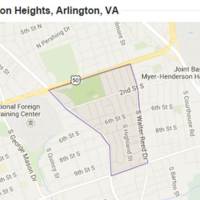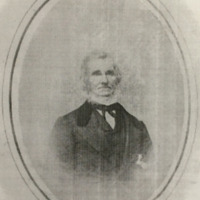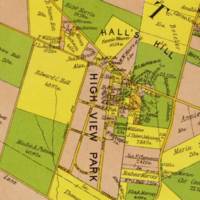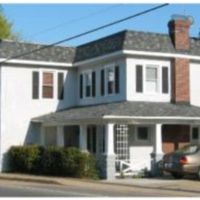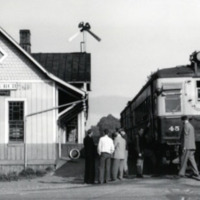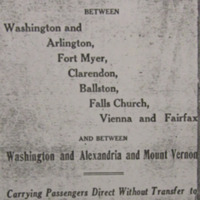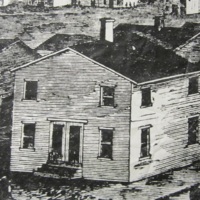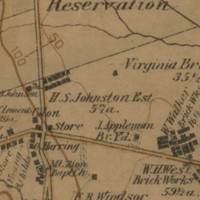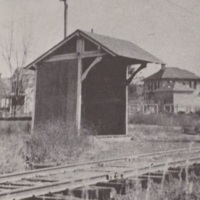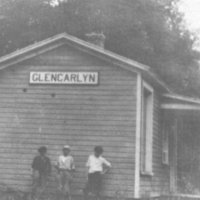Browse Items (41 items total)
Arlington Heights is a neighborhood bounded by Arlington Boulevard, South Fillmore Street, South Walter Reed Drive, Columbia Pike, and South Glebe Road. The area that would become Arlington Heights began in the early 1900s with the construction of 28 Craftsman-style Bungalow homes. These homes were located across 25 discreet subdivisions which came together to form Arlington Heights. From 1936 to 1942 construction surged in Arlington Heights with numerous brick Colonial Revival-style homes and a garden-style apartment being constructed within the neighborhood. The neighborhood also features one high-rise apartment building, a commercial building, a synagogue, a parsonage, a middle school with community center and two landscaped parks. The last major construction projects were completed in 1978. Arlington Heights was put on the National Register of Historic Places in 2008.
Collection: Neighborhoods
Bazil Hall is the namesake of the Hall's Hill community. Hall moved from Washington, D.C. in 1852 to Arlington where he purchased 327 acres of land to farm. During the Civil War his home and land were damaged first by a skirmish between Union and Confederate forces and then by a Union encampment on his property. Before the war Hall's estate was valued at $25,000, but following the war it was valued at only $6,4000. Despite deep seated prejudices, Hall decided to sell his land to formerly enslaved African Americans following the war in order to stay afloat. This led to the creation to the Hall's Hill community, today called High View Park.
Collection: Neighborhoods
The community of Hall's Hill, today called High View Park, was established in 1865 when white land-owner Bazil Hall, hit with hard-times following the Civil War, sold lots of his land to formerly enslaved African Americans. From these beginnings Hall's Hill became a thriving black community.
Local community institutions of note include Glebe Elementary School, Langston Brown Community Center, Calloway United Methodist Church, and Fire Station #8, Arlington's first African American fire company. Hall's Hill is one of the few remaining African American neighborhoods in Arlington. During the mid-twentieth century, the bordering white community built a cinder-block wall around Hall's Hill to physical separate themselves from their black neighbors during formal, legalized residential segregation. Pieces of that wall remain.
The community is bounded North by Lee Highway, East by Glebe Road, South by 17th Street North, and West by George Mason Drive. This map shows the growing community in 1900.
Local community institutions of note include Glebe Elementary School, Langston Brown Community Center, Calloway United Methodist Church, and Fire Station #8, Arlington's first African American fire company. Hall's Hill is one of the few remaining African American neighborhoods in Arlington. During the mid-twentieth century, the bordering white community built a cinder-block wall around Hall's Hill to physical separate themselves from their black neighbors during formal, legalized residential segregation. Pieces of that wall remain.
The community is bounded North by Lee Highway, East by Glebe Road, South by 17th Street North, and West by George Mason Drive. This map shows the growing community in 1900.
Collection: Neighborhoods
At Hunter Station the Fort Myer Branch of the Washington, Alexandria, and Falls Church commuter rail line met with trolley car lines. Hunter Station was located within the African American Butler-Holmes community, today called Penrose. With connections to Rosslyn, Georgetown, and downtown Washington, these lines helped to expand Butler-Holmes throughout the early twentieth century. The community was also served by the Columbia Station near present-day Columbia Pike and Walter Reed Drive, but the station's exact location is not known. Today Hunter Station is a private residence.
Collection: Neighborhoods
This image shows East Falls Church Station on May 31, 1951, the last day of passenger service. This stop was originally opened as a part of the Washington, Arlington & Falls Church line in 1901 and became a part of the Washington-Virginia Railroad in 1913. The line had been in financial trouble since the 1920s as commuters increasingly turned to automobiles for travel. After a brief resurgence in use and support during World War Two, the line finally ended its passenger service in 1951.
Collection: Neighborhoods
The Washington-Virginia line was formed by a merger of the Washington, Alexandria, and Mt Vernon and the Washington Alexandria and Mt Vernon railroads.
This advertisement for the Washington-Virginia Railway highlights the lines' many connections to the neighborhoods of Arlington and downtown Washington, D.C. The advertisement boasts how the new line is "within a few minutes walk to all Theatres, Government Buildings, Department Stores," and more. This list of attractions highlights the social, cultural, and employment amenities available to Arlington residents with the expansion and opening of the trolley lines during the early twentieth century. With this increased connection to D.C. and the desire to live within suburban, single family homes the "Fort Myer, Clarendon, Ballston, and Falls Church" communities and more all continued to grow.
This advertisement for the Washington-Virginia Railway highlights the lines' many connections to the neighborhoods of Arlington and downtown Washington, D.C. The advertisement boasts how the new line is "within a few minutes walk to all Theatres, Government Buildings, Department Stores," and more. This list of attractions highlights the social, cultural, and employment amenities available to Arlington residents with the expansion and opening of the trolley lines during the early twentieth century. With this increased connection to D.C. and the desire to live within suburban, single family homes the "Fort Myer, Clarendon, Ballston, and Falls Church" communities and more all continued to grow.
Collection: Neighborhoods
Freedman's Village was a contraband camp created by the War Department and strengthened by Arlington's African American community. The Village, located on the lands of Robert E. Lee's Arlington plantation, was a black neighborhood in Arlington from 1863 until 1900.
Here 100 white-washed, one-and-a-half story duplexes, like the one pictured, were constructed along a quarter-mile long thoroughfare through the Village. The clapboard houses used a paired-down version of the Classical Revival style. This housing type remained a popular choice for African American communities in Arlington throughout the early twentieth century.
Here 100 white-washed, one-and-a-half story duplexes, like the one pictured, were constructed along a quarter-mile long thoroughfare through the Village. The clapboard houses used a paired-down version of the Classical Revival style. This housing type remained a popular choice for African American communities in Arlington throughout the early twentieth century.
Collection: Neighborhoods
Johnson's Hill, today known as Arlington View, is an African American community located along Columbia Pike which first began ca. 1880. Here a tollgate was created at the intersection of Columbia Pike and the Georgetown-Alexandria Pike (today South Arlington Ridge Road). A small village center with houses, two stores, a post office, and a blacksmith shop formed around this tollgate, helping to expand and strengthen this African American community.
Collection: Neighborhoods
The Washington and Old Dominion Railroad (W&OD) was founded in 1900 as the Great Falls and Old Dominion Railroad. The steam-rail line began in Rosslyn and extended out to various Arlington neighborhoods, including Cherrydale (1904) and Great Falls (1906). The W&OD continued to expand beyond the county by connecting to the Great Falls and Bluemont lines at the Bon Air neighborhood junction. Their service to Great Falls was discontinued in the 1930s, when their right-of-way was transferred to become Old Dominion Drive. The Bluemont line was aquired by the Southern Railroad in 1944 and continued service until 1968. Today the former W&OD line is a popular biking path.
Trolley transportation helped to strengthen and expand Arlington's suburban environment at the turn of the century.
The stop featured in this photograph is the Alexandria Junction along present day Route 1.
Trolley transportation helped to strengthen and expand Arlington's suburban environment at the turn of the century.
The stop featured in this photograph is the Alexandria Junction along present day Route 1.
Collection: Neighborhoods
This steam railroad began as the Alexandria, Loudon, and Hampshire Railroad in the 1850s. The line ran from Alexandria City, up the Four Mile Run Valley, past the Glencarlyn neighborhood (whose stop is pictured) and out to Herndon, Leesburg, and Bluemont. In 1911 the line was taken over by the Washington and Old Dominion Railroad (W&OD) and converted to electric-rail the following year. The W&OD was in service until 1968.
The Glencarlyn stop in pictured here. By 1900 trolley lines linked the new and expanding suburban communities of Glencarlym, Clarendon, Ballston, Cherrydale, Bon Air, and Barcroft. The rail became the fastest and most efficient way to travel within the county and beyond.
The Glencarlyn stop in pictured here. By 1900 trolley lines linked the new and expanding suburban communities of Glencarlym, Clarendon, Ballston, Cherrydale, Bon Air, and Barcroft. The rail became the fastest and most efficient way to travel within the county and beyond.
Collection: Neighborhoods
